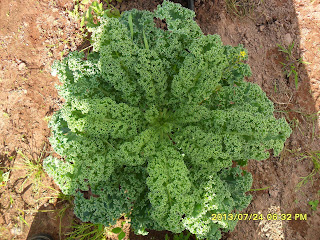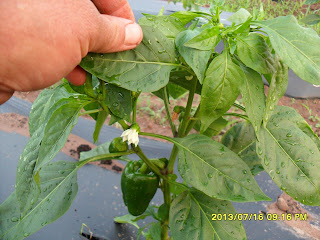Been a little while since I last posted. I would like to keep up with this blog a little more regularly, but my inclination seems more toward actually growing things, rather then writing about growing those things. However, as I sit here writing, the rain is gently pattering on the roof- so what a good time to update. Ah, this rain is a blessed relief after the beastly hot day. It will also be good for the about 200 new baby lettuces and some Red Beard bunching onions we set out as it started drizzling. The thunder was booming sporadically overhead for a little while, and a little lightning as we were setting them out, but we got them planted and headed into the house. Kinda loony, I know, being outside in those conditions, but, as my dad has said before, if you're not living on the edge you're taking up too much space. <Laughing>
 | ||
| Looking west from the roof of my rattly old farm truck. |
 | ||
| Young "Nevada" lettuce in the garden area known as "C-plot". |
The next one is kinda funny. One of my brothers and his wife and kids recently went out east. While there, he stopped in at Eliot Coleman's Four Season Farm. Eliot has been probably the biggest influence in my market gardening vocation. I have four of his books, and have been greatly inspired by his model of farming. Anyhow, my brother stopped there, walked through the greenhouses and fields, and got some produce at the farmstand. One of the things he purchased there was one of the beautiful beefsteak tomatos. He made sure to save one to bring home to us.
 |
| Yes, indeedy, it was as tasty as it was beautiful. :) |
not tied up as nicely as I would like, but as I once heard another gardener say, "Done is better than perfect."
Now, on to vermi-composting. For those not familiar with the term, it is essentially using earthworms (usually red wrigglers) to digest organic matter, turning it into what is called worm castings. I originally wanted to make some worm beds and raise worms, to supplement chicken feed for our laying hens. We got one made, put in some compost and worms, and have been adding goat manure and spent lettuce and kitchen scraps. The system isn't running perfectly yet,and we are still learning what it takes to keep the little critters happy, but we have been able to harvest some worm castings. Looks a little like this, worm poo mixed with some not totally digested organic matter.
The above is plant food par excellence, I believe better than anything to be found in a plastic bag on the feed store shelf. If I had a semi-load of it, I'd be in my glory. As it is, until we get lots more worm beds going, we have to use it more sparingly, lightly applying it to the garden beds and mixing with water for soil drenching. Worms are one of the gardener's best friends, loosening the soil, helping in the cycle of breaking down organic matter, and leaving behind their nutrient-rich droppings. I'm so glad God made 'em. :)
Another thing I've been learning more about lately is permaculture. I've heard about it before, but never really gave it much thought. Then a friend from South Carolina dropped in for a visit this spring, and as we were chatting in the warm sunny greenhouse, he mentioned the building of what are known as "hugelbeds". Basically, trenches are dug, logs are laid in (better yet if they have already started to decompose), then some nitrogen-rich matter is added on top of the logs (I'd use things like green grass, goat manure, maybe a little bloodmeal or alfalfa meal or comfrey leaves); then the whole heap is covered with earth. It seems some of the benefits of these hugelbeds are earlier warming in spring and staying warmer later in the fall (from the decaying action of the logs), good drainage, and the logs soak up water like a sponge in the wetter seasons, and make it available to the plants when they need it. The decomposing logs break down for years, thereby feeding the soil and plants. I also have (perhaps irrational) ideas like planting tomatos along the inner facing sides of two parallel mounded beds, then when cool fall weather starts, putting little hoops over the valley between the two beds, cover with plastic, and basically create a mini-climate with the two mounds as the "walls" and the little hoops along the top as the "roof" of a growing tunnel. Kinda hard to explain, but it might work. I'd love to get a "real greenhouse" someday, but try not to take on debt, so I use sometimes unorthodox methods to make do until we can get one. :)
I hope to make a couple of these hugelbeds this fall, and plant a little of each crop we grow in them next spring, just to give it a whirl. I am reluctant to change over totally to something I am not familiar with, replacing what I know works all at once, but if there is something to this hugelkultur, I'll start changing over more and more to it. Obviously, making a bunch of buried log piles in my field will be a somewhat permanent thing, with the logs decomposing for years. Here's a link to a short video for those who are interested, about Sepp Holzer, who is one of the pioneers of the permaculture movement.
http://www.youtube.com/watch?v=Bw7mQZHfFVE
There is a lot more out there if you would like to dig into it. I'm pretty excited about it. Well, I'm gonna run along now, leaving you with a beautiful sunrise photo over Keweenaw Bay, taken last fall.
Now, on to vermi-composting. For those not familiar with the term, it is essentially using earthworms (usually red wrigglers) to digest organic matter, turning it into what is called worm castings. I originally wanted to make some worm beds and raise worms, to supplement chicken feed for our laying hens. We got one made, put in some compost and worms, and have been adding goat manure and spent lettuce and kitchen scraps. The system isn't running perfectly yet,and we are still learning what it takes to keep the little critters happy, but we have been able to harvest some worm castings. Looks a little like this, worm poo mixed with some not totally digested organic matter.
 | |||||
| Thanks, son Joshua, for displaying a handful of worm poo and compost. :) |
The above is plant food par excellence, I believe better than anything to be found in a plastic bag on the feed store shelf. If I had a semi-load of it, I'd be in my glory. As it is, until we get lots more worm beds going, we have to use it more sparingly, lightly applying it to the garden beds and mixing with water for soil drenching. Worms are one of the gardener's best friends, loosening the soil, helping in the cycle of breaking down organic matter, and leaving behind their nutrient-rich droppings. I'm so glad God made 'em. :)
Another thing I've been learning more about lately is permaculture. I've heard about it before, but never really gave it much thought. Then a friend from South Carolina dropped in for a visit this spring, and as we were chatting in the warm sunny greenhouse, he mentioned the building of what are known as "hugelbeds". Basically, trenches are dug, logs are laid in (better yet if they have already started to decompose), then some nitrogen-rich matter is added on top of the logs (I'd use things like green grass, goat manure, maybe a little bloodmeal or alfalfa meal or comfrey leaves); then the whole heap is covered with earth. It seems some of the benefits of these hugelbeds are earlier warming in spring and staying warmer later in the fall (from the decaying action of the logs), good drainage, and the logs soak up water like a sponge in the wetter seasons, and make it available to the plants when they need it. The decomposing logs break down for years, thereby feeding the soil and plants. I also have (perhaps irrational) ideas like planting tomatos along the inner facing sides of two parallel mounded beds, then when cool fall weather starts, putting little hoops over the valley between the two beds, cover with plastic, and basically create a mini-climate with the two mounds as the "walls" and the little hoops along the top as the "roof" of a growing tunnel. Kinda hard to explain, but it might work. I'd love to get a "real greenhouse" someday, but try not to take on debt, so I use sometimes unorthodox methods to make do until we can get one. :)
I hope to make a couple of these hugelbeds this fall, and plant a little of each crop we grow in them next spring, just to give it a whirl. I am reluctant to change over totally to something I am not familiar with, replacing what I know works all at once, but if there is something to this hugelkultur, I'll start changing over more and more to it. Obviously, making a bunch of buried log piles in my field will be a somewhat permanent thing, with the logs decomposing for years. Here's a link to a short video for those who are interested, about Sepp Holzer, who is one of the pioneers of the permaculture movement.
http://www.youtube.com/watch?v=Bw7mQZHfFVE
There is a lot more out there if you would like to dig into it. I'm pretty excited about it. Well, I'm gonna run along now, leaving you with a beautiful sunrise photo over Keweenaw Bay, taken last fall.
 |
| The gracious sun with light now brightens.... |

























